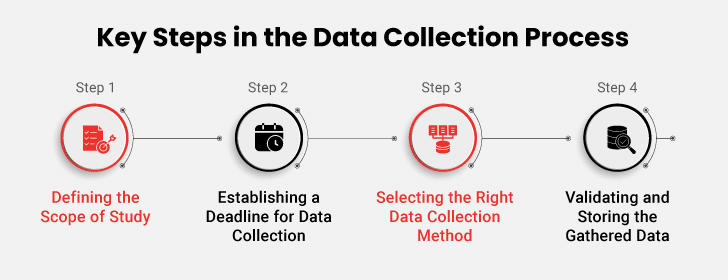Picture this: In the rhythmic hum of a factory floor, every pause, every beep of the machine, and every imperfect part tells a story waiting to be decoded. Even the most basic manufacturing metrics hold the power to transform operations when captured consistently and analyzed thoughtfully.

Take the case of a manufacturing unit where staff dedicatedly track conveyor belt downtimes, time taken to assemble one product, the count of widgets manufactured in 24 hours, and number of defective screws found during inspection. This systematic record keeping on the shop floor is data collection in the simplest form. Thorough processing and analysis of collected data offers insights that drive informed decisions, optimize resource allocation, leverage a proactive over reactive approach, and maximize outputs.
Table of Contents
Whether conducting academic research or trying to understand social dynamics and consumer behavior in the commercial sector, you need data to make informed decisions. Data collection is, therefore, the first and fundamental step of every research endeavor, laying the foundation for the rest of the study.
Understanding Data Collection in Research
Data collection is a systematic process of gathering information from multiple sources such as the Internet, published journals, grievances, etc. The goal is to achieve a comprehensive dataset that enables researchers to test hypotheses, answer research questions, evaluate outcomes, and forecast trends and probabilities.
Data collection is essential for research, analysis, and decision-making processes, whether for academics, social sciences, businesses, governments, etc. A meticulously executed data collection process ensures the accuracy, reliability, and relevance of the research findings. Mastering the various data collection techniques in research empowers scholars and practitioners to achieve precision that lends credibility to their work. Therefore, it is right to say that data collection is the backbone of effective research.
Data Collection as the Backbone of Effective Research
Data collection is a fundamental process of the research lifecycle, bridging the gap between theoretical inquiry and empirical evidence. Its importance cannot be overstated, as effective data collection ensures that the research findings are based on concrete proof, leading to credible solutions. At the same time, the challenge lies in ensuring that the gathered data is accurate and relevant to the research objective.
The data quality used for research directly impacts the outcomes’ validity, influencing subsequent interpretation, analysis, and recommendations. Accurate data serves as the bedrock for actionable insights, ensuring that the research aligns with its intended objectives. Moreover, researchers risk basing their conclusions on incomplete, biased, and erroneous information without a robust data collection process.
At the same time, data collection is not a simple process. Depending on the factors, including the nature of the research, the questions it aims to address, and the scope, determine its complexity. For instance, a guy with a clipboard questioning random strangers is also a type of data collection. It can also be gathered through other means, such as mail-in comment cards or a telephonic survey. However, the data collected through all these methods differs.
Whether quantitative, qualitative, or mixed-methods research, the strategies employed must align with the research goals while adhering to ethical standards. Mastering this process is important in the data-driven world, where decisions across industries rely on research findings.
Data Collection or Extraction – Which One Do You Need?
Overview of the Data Collection Process in Research
Data collection in research is a step-by-step process, details of which are listed below:

Step 1: Defining the Scope of Study
The first step is identifying the research objectives to understand the data type required. It includes defining the scope of the study, determining the research questions, and the sources used to collect the required data. For instance, researchers can choose to gather information on the type of protein an average gym enthusiast between the ages of 20 and 30 most frequently searched for.
Step 2: Establishing a Deadline for Data Collection
Data is constantly collected, such as determining the total time an average user between the ages of 40 and 50 spends on social media. Or businesses planning to revamp the website track transactional data and website visitor statistics over the long term. Contrarily, there are instances when data is collected for a particular period. For instance, determining the most preferred dairy product during winter or tracking a particular campaign. In such scenarios, establishing a timeline for data collection is important.
Step 3: Selecting the Right Data Gathering Methods
The next stage involves selecting the most suitable data collection methods for research. Depending on the nature of the study, researchers may opt for primary or secondary data collection. Primary data is obtained directly from the source through methods such as surveys, interviews, or experiments. Secondary data, on the other hand, involves analyzing pre-existing datasets, such as government records, academic publications, or industry reports.
Step 4: Validating and Storing the Gathered Data
After selecting the data collection method, researchers design tools to gather data effectively. These tools must be tailored to the target audience and the research context, ensuring they capture accurate and relevant information. The final stages of the process involve data collection, validation, and storage. Ethical considerations, such as informed consent and confidentiality, must also be prioritized throughout the process.
As evident, the approach leveraged to collect data has a substantial impact on the validity, reliability, and accuracy of the findings. Therefore, researchers, analysts, and businesses should know the different data collection methods.
Master Data Accuracy with a Foolproof Guide to Automated Data Validation
Key Data Collection Methods in Research
The choice of data collection method depends on the research plan, the type of data required, and the resources available. Broadly, these methods can be categorized into qualitative and quantitative approaches. Quantitative data collection focuses on numerical data that can be measured, analyzed, and interpreted statistically. This approach is commonly used in studies that aim to identify patterns, test hypotheses, or establish relationships between variables.
On the other hand, qualitative data collection focuses on understanding events through non-numerical data. This approach delves into the “why” and “how” of a subject, capturing rich, detailed insights that quantitative methods may overlook. Here are different methods:
1. Surveys and Questionnaires: Right Way to Know Your Audience
Surveys are most widely used to gather large volumes of data in social sciences, healthcare, and market research. They offer a structured approach to effectively collect demographic information, preferences, and behaviors. Questionnaires, a subset of surveys, use pre-designed questions to ensure consistency and comparability across responses.
Think of researching consumer behavior towards sustainable products. A well-structured survey distributed through online platforms is ideal for collecting data from hundreds and thousands of respondents. Ensure that the questions are precise and directly related to the research objectives.
Pro Tip: Ensure the survey is brief, crisp, and engaging to increase the response rate.
2. Experiments: Testing Hypotheses in Regulated Environments
The very core of scientific studies is experimentation, enabling researchers to understand cause-and-effect relationships by manipulating one or more variables. This method is particularly effective in controlled environments where external factors can be minimized. Experimental research is frequently employed in fields such as psychology, medicine, and engineering.
Consider analyzing the effectiveness of a new teaching strategy on students’ performance. For this, students can be split into two groups, one utilizing the new strategy and the other the traditional approach. Comparing the two outcomes helps determine whether the approach has a significant impact.
Pro Tip: Ensure the experiment is well-designed by employing random assignment and controlling extraneous variables to reduce bias.
3. Observations: Seeing is Believing
Observations involve systematically recording behaviors or events in their natural contexts. This method is valuable for studies that require real-time data, such as monitoring consumer behavior or assessing workplace efficiency. Thus, it is widely used in areas such as education, behavioral psychology, and anthropology.
For instance, a researcher interested in classroom dynamics would observe a class for a few weeks and record how the students engage with their teacher and one another. This approach provides a true outlook to the researcher on the behavior in the real world without changing the surroundings.
Pro Tip: As observation is subjective, the observer bias may creep in unintentionally. To mitigate this, consider employing multiple observers or documenting the observations for subsequent evaluation.
4. Interviews: Key to Detailed Individual POVs
Interviews provide an in-depth perspective on participants’ experiences, beliefs, and attitudes. These are used in qualitative research as interviews offer a personal approach to collecting data. These can be conducted face-to-face, over the phone, or via video conferencing. Their flexibility allows researchers to explore complex topics and probe further into participants’ responses.
Suppose a researcher plans to study the challenges faced by small, home-grown businesses during the deadly COVID-19 pandemic. Semi-structured interviews with pre-determined questions are the best way to get the answers and explore new topics that may emerge during the conversation.
Pro Tip: Make sure that the interviewee is comfortable during the process to get the most out of the interviews. Additionally, actively listen to what the interviewee says and follow up with probing questions.
5. Focus Groups: Gathering Shared Insights
Focus groups involve guided discussions with a small group of participants, encouraging the exchange of ideas and viewpoints. This method is particularly useful for understanding collective attitudes, cultural nuances, and social dynamics, exploring complex issues, and generating new ideas.
For instance, a business developing a new app can conduct focus groups to understand the requirements and preferences of potential customers. They can obtain diverse viewpoints by facilitating discussions that might not surface in one-on-one interviews.
Pro Tip: A skilled moderator is essential for focus groups to ensure everyone participates and the conversation stays on course.
6. Ethnography: Immersing Oneself in a Community
Ethnography involves immersing oneself in a community or setting to observe behaviors, rituals, and interactions. This method is common in anthropology and sociology, providing holistic insights into the context of a study.
Take the case of a researcher studying the impact of tourism on a small village. Undoubtedly, ethnography is the right way to gather data. It involves living in the village for several months, participating in daily activities, and building relationships with the locals to understand their perspectives.
Pro Tip: Cultural sensitivity and a substantial time investment are necessary for ethnography. Gaining the participants’ trust is essential to collecting reliable data.
7. Case Studies: A Comprehensive Examination of an Instance
A cast study is an in-depth examination of a single case in a real-life context. This approach is used to explore topics in business, law, social sciences, etc., in detail.
Think of investigating a company that had a successful turnaround during the pandemic. A case study helps examine the strategies employed, challenges encountered, and the outcomes of decisions — everything in detail.
Pro Tip: When conducting a case study, triangulate your data using a variety of sources, including observations, interviews, and documents to get a comprehensive view of the case.
8. Mixed-Methods Approaches
Mixed-methods research integrates both quantitative and qualitative data-gathering techniques to provide a comprehensive understanding of the subject. This approach is especially valuable for addressing complex research questions that require multiple perspectives.
For example, a study on consumer preferences might combine survey data with focus group discussions to capture both statistical trends and nuanced opinions.

As evident, various data-gathering techniques in research serve specific purposes. What works best for one researcher might not be effective for another. Likewise, there are multiple tools to gather qualitative and quantitative data, and researchers must know these to make an informed choice.
Data Gathering Tools in Research
1. Word Association: After providing the respondents with a list of words, the researcher asks them to describe what first comes to mind when they hear each word.
2. Sentence Completion: To understand the respondent’s thoughts, researchers employ sentence completion. This tool involves giving the interviewee an incomplete sentence and watching how they complete it.
3. Role-Playing: Respondents are given a hypothetical scenario and instructed to act or respond as though it were genuine.
4. In-Person Surveys: Needless to say, questions are asked in person.
5. Online/Web Surveys: Although these surveys are easy to complete, some users may not want to answer honestly, if at all.
Ethical Considerations in Data Collection
Ethics play a central role in the data collection process, ensuring that participants’ rights, privacy, and well-being are protected. Researchers must adhere to ethical guidelines, such as obtaining informed consent, maintaining confidentiality, and ensuring data security.
1. Informed Consent: Participants must be fully aware of the study’s purpose, procedures, and potential risks before agreeing to participate. Informed consent ensures that participation is voluntary and based on a clear understanding of the research.
2. Confidentiality: Protecting participants’ identities and personal information is a fundamental ethical obligation. Researchers must implement measures such as anonymization and secure data storage to safeguard confidentiality.
3. Data Integrity: Ensuring the accuracy and authenticity of data is vital. Researchers must avoid practices such as falsifying data, selectively reporting results, or misrepresenting findings.
Faster, Accurate, and Secure Data Collection Services
Concluding Thoughts
Mastering data collection techniques in research is imperative to achieve accurate, reliable, and actionable insights. By understanding the nuances of different methods and tools, researchers can develop a robust data collection process that aligns with their objectives. At the same time, ethical considerations and correct methods are crucial for gathering data effectively and ensuring the validity of findings.
As the research landscape continues to evolve, the importance of precision in data collection cannot be overstated. From surveys and interviews to digital tools and mixed methods approaches, the possibilities for gathering data are vast. By effectively leveraging these techniques, researchers can contribute to the advancement of knowledge and the development of solutions that address complex societal challenges.





